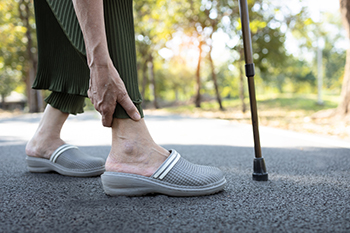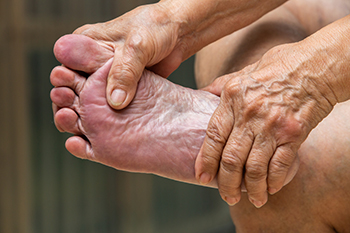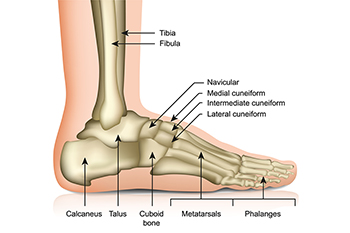Items filtered by date: November 2023
Ankle Pain in the Elderly

Ankle pain in seniors can significantly affect mobility and quality of life. It often results from wear and tear on the ankle joint, leading to conditions such as osteoarthritis, where the cartilage cushioning the bones wears down. Another common cause is rheumatoid arthritis, an autoimmune condition that can cause joint pain and swelling. Ankle pain may also stem from past injuries, such as sprains or fractures that did not heal properly, or from changes in gait and balance as one ages. Poor circulation, gout, and nerve damage including peripheral neuropathy can contribute as well. It is important for seniors experiencing ankle pain to consult a podiatrist who can diagnose the cause accurately. Treatment may include medication for pain and inflammation, or wearing supportive braces or footwear. In some cases, if conservative treatments are not effective, surgical options may be considered. If you are a senior and experiencing ankle pain, it is suggested that you make an appointment with a podiatrist for an accurate diagnosis and treatment options.
Ankle pain can be caused by a number of problems and may be potentially serious. If you have ankle pain, consult with one of our podiatrists from Parkwood Podiatry. Our doctors will assess your condition and provide you with quality foot and ankle treatment.
Ankle pain is any condition that causes pain in the ankle. Due to the fact that the ankle consists of tendons, muscles, bones, and ligaments, ankle pain can come from a number of different conditions.
Causes
The most common causes of ankle pain include:
- Types of arthritis (rheumatoid, osteoarthritis, and gout)
- Ankle sprains
- Broken ankles
- Achilles tendonitis
- Achilles tendon rupture
- Stress fractures
- Bursitis
- Tarsal tunnel syndrome
- Plantar fasciitis
Symptoms
Symptoms of ankle injury vary based upon the condition. Pain may include general pain and discomfort, swelling, aching, redness, bruising, burning or stabbing sensations, and/or loss of sensation.
Diagnosis
Due to the wide variety of potential causes of ankle pain, podiatrists will utilize a number of different methods to properly diagnose ankle pain. This can include asking for personal and family medical histories and of any recent injuries. Further diagnosis may include sensation tests, a physical examination, and potentially x-rays or other imaging tests.
Treatment
Just as the range of causes varies widely, so do treatments. Some more common treatments are rest, ice packs, keeping pressure off the foot, orthotics and braces, medication for inflammation and pain, and surgery.
If you have any questions, please feel free to contact our offices located in Brunswick and Hinesville, GA . We offer the newest diagnostic and treatment technologies for all your foot care needs.
Understanding the Causes of Purple Feet in Elderly Individuals

The emergence of purple-hued feet in the elderly can be a mystifying occurrence, signaling an array of potential underlying factors. Reduced blood circulation, often a consequence of aging, can contribute to this discoloration as blood struggles to reach the extremities. Chronic venous insufficiency, where veins struggle to pump blood back to the heart, may intensify the purple color. Additionally, peripheral artery disease, a condition involving narrowed arteries, can impede blood flow, casting a violet shadow over the feet. Diabetes, a common companion of aging, may also play a role, influencing blood vessel integrity. Medications, inadequate hydration, or prolonged periods of immobility are other facets of the intricate tapestry that could contribute to this phenomenon. If this condition applies to you, or if you are caring for someone who has this ailment, it is suggested that a podiatrist be consulted who can accurately determine what the cause is, and offer correct treatment options.
Proper foot care is something many older adults forget to consider. If you have any concerns about your feet and ankles, contact one of our podiatrists from Parkwood Podiatry. Our doctors can provide the care you need to keep you pain-free and on your feet.
The Elderly and Their Feet
As we age we start to notice many changes in our body, but the elder population may not notice them right away. Medical conditions may prevent the elderly to take notice of their foot health right away. Poor vision is a lead contributor to not taking action for the elderly.
Common Conditions
- Neuropathy – can reduce feeling in the feet and can hide many life-threatening medical conditions.
- Reduced flexibility – prevents the ability of proper toenail trimming, and foot cleaning. If left untreated, it may lead to further medical issues.
- Foot sores – amongst the older population can be serious before they are discovered. Some of the problematic conditions they may face are:
- Gouging toenails affecting nearby toe
- Shoes that don’t fit properly
- Pressure sores
- Loss of circulation in legs & feet
- Edema & swelling of feet and ankles
Susceptible Infections
Diabetes and poor circulation can cause general loss of sensitivity over the years, turning a simple cut into a serious issue.
If you have any questions please feel free to contact our offices located in Brunswick and Hinesville, GA . We offer the newest diagnostic and treatment technologies for all your foot and ankle needs.
How Foot Bones Work Together in Unison

The human foot is a marvel of engineering, with a complex network of 26 bones working seamlessly in unison to support our body weight and enable a wide range of movements. These bones can be categorized into three main groups, known as the tarsal bones in the ankle, metatarsals in the arch, and phalanges in the toes. Tarsal bones provide the foot's stability and shock-absorbing capacity. They bear the weight and help transmit the forces generated during activities. Metatarsals form the foot's longitudinal arch, creating a flexible structure that acts as a lever during walking, running, and jumping. The phalanges, or toes, contribute to balance and provide dexterity. The biomechanics of the feet rely on an extensive network of muscles, tendons, and ligaments. Together, they allow for precise and controlled movements. When all components function harmoniously, the foot operates efficiently, ensuring that we can walk, run, and stand with stability and grace. Understanding this collaboration among foot bones highlights the importance of proper foot care and maintenance for a lifetime of healthy and pain-free mobility. If you would like additional information about the intricacies of the feet, it is suggested that you consult a podiatrist who can provide you with the information you are seeking.
If you have any concerns about your feet, contact one of our podiatrists from Parkwood Podiatry. Our doctors can provide the care you need to keep you pain-free and on your feet.
Biomechanics in Podiatry
Podiatric biomechanics is a particular sector of specialty podiatry with licensed practitioners who are trained to diagnose and treat conditions affecting the foot, ankle and lower leg. Biomechanics deals with the forces that act against the body, causing an interference with the biological structures. It focuses on the movement of the ankle, the foot and the forces that interact with them.
A History of Biomechanics
- Biomechanics dates back to the BC era in Egypt where evidence of professional foot care has been recorded.
- In 1974, biomechanics gained a higher profile from the studies of Merton Root, who claimed that by changing or controlling the forces between the ankle and the foot, corrections or conditions could be implemented to gain strength and coordination in the area.
Modern technological improvements are based on past theories and therapeutic processes that provide a better understanding of podiatric concepts for biomechanics. Computers can provide accurate information about the forces and patterns of the feet and lower legs.
Understanding biomechanics of the feet can help improve and eliminate pain, stopping further stress to the foot.
If you have any questions please feel free to contact our offices located in Brunswick and Hinesville, GA . We offer the newest diagnostic and treatment technologies for all your foot and ankle needs.
Risks of Chronic Ankle Instability

Ankle sprains are a common occurrence, especially among active individuals, but for some, they can be a recurrent and frustrating issue. Ankle sprains most frequently occur when the ligaments on the outside of the ankle are stretched or torn as the joint moves beyond its normal range of motion. Many such sprains may appear minor, with minimal swelling and mobility problems. However, if recurrent, they can have a cumulative effect and produce lasting consequences, leading to chronic ankle instability. Once you have experienced an ankle sprain, you are more likely to have another. Studies have shown that a history of lateral ankle sprains can disrupt the structural integrity of ligaments in the joint. As a result, up to 70% of patients report feelings of instability and recurrent ankle sprain injuries. Consequences include a reduced quality of life and an increased risk of early-onset osteoarthritis. Also, people with a history of ankle sprains often become progressively sedentary, are more likely to gain weight, and experience more general body pain. Methods to reduce the risk of another sprain include wearing an ankle brace and performing a series of exercises designed to strengthen the ankle joint. For help with recurring ankle sprains or instability, it is suggested that you make an appointment with a podiatrist for a full assessment and appropriate treatment options.
Ankle sprains are common but need immediate attention. If you need your feet checked, contact one of our podiatrists from Parkwood Podiatry. Our doctors can provide the care you need to keep you pain-free and on your feet.
How Does an Ankle Sprain Occur?
Ankle sprains take place when the ligaments in your ankle are torn or stretched beyond their limits. There are multiple ways that the ankle can become injured, including twisting or rolling over onto your ankle, putting undue stress on it, or causing trauma to the ankle itself.
What Are the Symptoms?
- Mild to moderate bruising
- Limited mobility
- Swelling
- Discoloration of the skin (depending on severity)
Preventing a Sprain
- Wearing appropriate shoes for the occasion
- Stretching before exercises and sports
- Knowing your limits
Treatment of a Sprain
Treatment of a sprain depends on the severity. Many times, people are told to rest and remain off their feet completely, while others are given an air cast. If the sprain is very severe, surgery may be required.
If you have suffered an ankle sprain previously, you may want to consider additional support such as a brace and regular exercises to strengthen the ankle.
If you have any questions please feel free to contact our offices located in Brunswick and Hinesville, GA . We offer the newest diagnostic and treatment technologies for all your foot and ankle needs.

